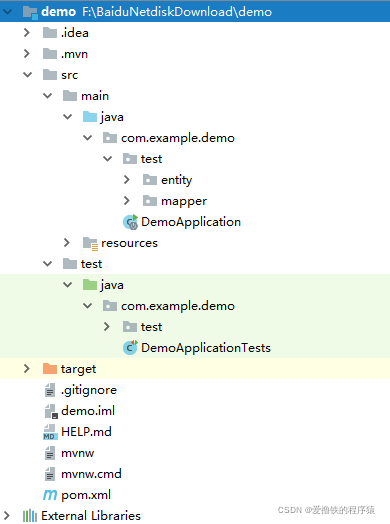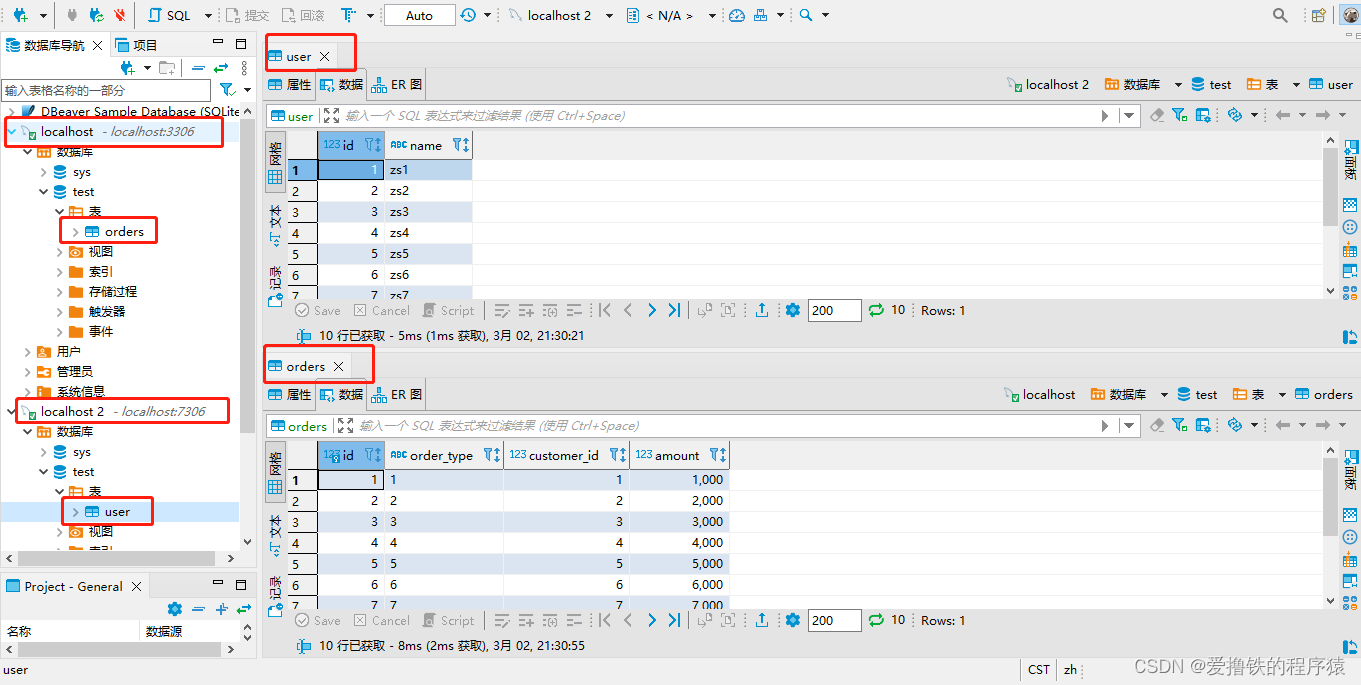场景:订单表和用户表存在不同数据库中
一、创建一个springboot项目,结构如下

二、pom.xml直接粘贴过去(了解一下jar包作用!)
<?xml version="1.0" encoding="UTF-8"?>
<project xmlns="http://maven.apache.org/POM/4.0.0" xmlns:xsi="http://www.w3.org/2001/XMLSchema-instance"
xsi:schemaLocation="http://maven.apache.org/POM/4.0.0 https://maven.apache.org/xsd/maven-4.0.0.xsd">
<modelVersion>4.0.0</modelVersion>
<parent>
<groupId>org.springframework.boot</groupId>
<artifactId>spring-boot-starter-parent</artifactId>
<version>2.3.2.RELEASE</version>
<relativePath/> <!-- lookup parent from repository -->
</parent>
<groupId>com.example</groupId>
<artifactId>shardingsphere_demo</artifactId>
<version>0.0.1-SNAPSHOT</version>
<name>shardingsphere_demo</name>
<description>Demo project for Spring Boot</description>
<properties>
<java.version>1.8</java.version>
</properties>
<dependencies>
<!--提供了数据源配置、事务管理、数据访问等等功能-->
<dependency>
<groupId>org.springframework.boot</groupId>
<artifactId>spring-boot-starter-jdbc</artifactId>
</dependency>
<!--1.自动发现存在的DataSource-->
<!--2.利用SqlSessionFactoryBean创建并注册SqlSessionFactory-->
<!--3.创建并注册SqlSessionTemplate-->
<!--4.自动扫描Mappers,并注册到Spring上下文环境方便程序的注入使用-->
<dependency>
<groupId>org.mybatis.spring.boot</groupId>
<artifactId>mybatis-spring-boot-starter</artifactId>
<version>2.1.3</version>
</dependency>
<!--Druid为监控而生的数据库连接池,它是阿里巴巴开源平台上的一个项目-->
<dependency>
<groupId>com.alibaba</groupId>
<artifactId>druid</artifactId>
<version>1.1.23</version>
</dependency>
<!--核心依赖-sharding-jdbc-->
<dependency>
<groupId>org.apache.shardingsphere</groupId>
<artifactId>sharding-jdbc-spring-boot-starter</artifactId>
<version>4.1.1</version>
</dependency>
<!-- mysql依赖-->
<dependency>
<groupId>mysql</groupId>
<artifactId>mysql-connector-java</artifactId>
<scope>runtime</scope>
</dependency>
<!-- 测试依赖-->
<dependency>
<groupId>org.springframework.boot</groupId>
<artifactId>spring-boot-starter-test</artifactId>
<scope>test</scope>
<exclusions>
<exclusion>
<groupId>org.junit.vintage</groupId>
<artifactId>junit-vintage-engine</artifactId>
</exclusion>
</exclusions>
</dependency>
</dependencies>
<build>
<plugins>
<!-- 打包插件-->
<plugin>
<groupId>org.springframework.boot</groupId>
<artifactId>spring-boot-maven-plugin</artifactId>
</plugin>
<!--maven里执行测试用例的插件-->
<plugin>
<groupId>org.apache.maven.plugins</groupId>
<artifactId>maven-surefire-plugin</artifactId>
<configuration>
<skipTests>true</skipTests>
</configuration>
</plugin>
</plugins>
</build>
</project>
三、创建实体类
package com.example.demo.test.entity;
public class Orders {
private Integer id;
private Integer orderType;
private Integer customerId;
private Double amount;
public Integer getId() {
return id;
}
public void setId(Integer id) {
this.id = id;
}
public Integer getOrderType() {
return orderType;
}
public void setOrderType(Integer orderType) {
this.orderType = orderType;
}
public Integer getCustomerId() {
return customerId;
}
public void setCustomerId(Integer customerId) {
this.customerId = customerId;
}
public Double getAmount() {
return amount;
}
public void setAmount(Double amount) {
this.amount = amount;
}
@Override
public String toString() {
return "Orders{" +
"id=" + id +
", orderType=" + orderType +
", customerId=" + customerId +
", amount=" + amount +
'}';
}
}
package com.example.demo.test.entity;
public class User {
private Integer id;
private String name;
public Integer getId() {
return id;
}
public void setId(Integer id) {
this.id = id;
}
public String getName() {
return name;
}
public void setName(String name) {
this.name = name;
}
@Override
public String toString() {
return "Customer{" +
"id=" + id +
", name='" + name + '\'' +
'}';
}
}
四、创建mapper类
package com.example.demo.test.mapper;
import com.example.demo.test.entity.Orders;
import org.apache.ibatis.annotations.*;
import org.springframework.stereotype.Repository;
@Repository
@Mapper
public interface OrdersMapper {
@Insert("insert into orders(id,order_type,customer_id,amount) values(#{id},#{orderType},#{customerId},#{amount})")
public void insert(Orders orders);
@Select("select * from orders where id = #{id}")
@Results({
@Result(property = "id",column = "id"),
@Result(property = "orderType",column = "order_type"),
@Result(property = "customerId",column = "customer_id"),
@Result(property = "amount",column = "amount")
})
public Orders selectOne(Integer id);
}
package com.example.demo.test.mapper;
import com.example.demo.test.entity.User;
import org.apache.ibatis.annotations.Insert;
import org.apache.ibatis.annotations.Mapper;
import org.springframework.stereotype.Repository;
@Repository
@Mapper
public interface UserMapper {
@Insert("insert into user(id,name) values(#{id},#{name})")
public void insertUser(User user);
}
四、修改application.properties配置文件(主要关注一下!)
#mybatis.type-aliases-package来指定POJO扫描包来让mybatis自动扫描到自定义的POJO
mybatis.type-aliases-package=com.example.demo.test
#配置数据源
spring.shardingsphere.datasource.names=ds1,ds2
#配置第一个数据源
spring.shardingsphere.datasource.ds1.type=com.alibaba.druid.pool.DruidDataSource
spring.shardingsphere.datasource.ds1.driver-class-name=com.mysql.jdbc.Driver
spring.shardingsphere.datasource.ds1.url=jdbc:mysql://localhost:3306/test?serverTimezone=UTC
spring.shardingsphere.datasource.ds1.username=root
spring.shardingsphere.datasource.ds1.password=123456
#配置第二个数据源
spring.shardingsphere.datasource.ds2.type=com.alibaba.druid.pool.DruidDataSource
spring.shardingsphere.datasource.ds2.driver-class-name=com.mysql.jdbc.Driver
spring.shardingsphere.datasource.ds2.url=jdbc:mysql://localhost:7306/test?serverTimezone=UTC
spring.shardingsphere.datasource.ds2.username=root
spring.shardingsphere.datasource.ds2.password=123456
#配置orders表所在的数据节点
spring.shardingsphere.sharding.tables.orders.actual-data-nodes=ds1.orders
#配置user表所在的数据节点
spring.shardingsphere.sharding.tables.user.actual-data-nodes=ds2.user
#user表的主键生成策略
spring.shardingsphere.sharding.tables.user.key-generator.column=id
spring.shardingsphere.sharding.tables.user.key-generator.type=SNOWFLAKE
#指定分片的策略
spring.shardingsphere.sharding.tables.user.table-strategy.inline.sharding-column=id
spring.shardingsphere.sharding.tables.user.table-strategy.inline.algorithm-expression=user
#显示sql
spring.shardingsphere.props.sql.show=true
五、数据库手动创建表结构
1.根据上面实体类在两个数据库中分别创建ordes表和user表
2.分片规则:将不同的表插入到不同的库中
六、创建测试类
package com.example.demo.test;
import com.example.demo.test.entity.Orders;
import com.example.demo.test.entity.User;
import com.example.demo.test.mapper.OrdersMapper;
import com.example.demo.test.mapper.UserMapper;
import org.junit.jupiter.api.Test;
import org.springframework.beans.factory.annotation.Autowired;
import org.springframework.boot.test.context.SpringBootTest;
@SpringBootTest
class ShardingsphereDemoApplicationTests {
@Autowired
private OrdersMapper ordersMapper;
@Autowired
private UserMapper userMapper;
@Test
public void addOrders(){
for (int i = 1; i <=10 ; i++) {
Orders orders = new Orders();
orders.setId(i);
orders.setCustomerId(i);
orders.setOrderType(i);
orders.setAmount(1000.0*i);
ordersMapper.insert(orders);
}
}
@Test
public void insertUser(){
for (int i = 1; i <= 10 ; i++) {
User user = new User();
user.setId(i);
user.setName("zs"+i);
userMapper.insertUser(user);
}
}
}
七、测试
分别执行addOrders()方法和insertUser()方法添加数据,结果如下

| 
